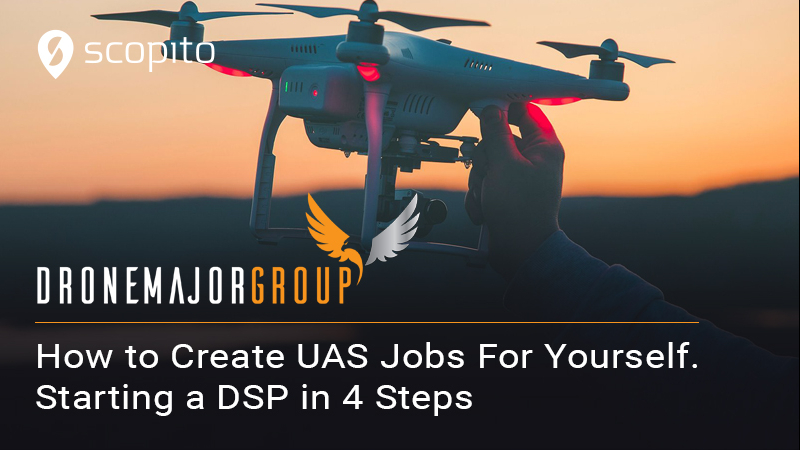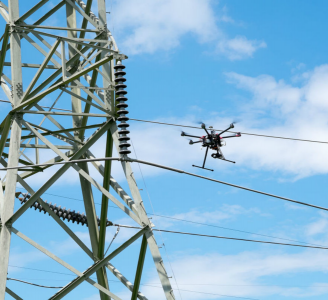Editorial Feature
How to create UAS jobs for yourself. Starting a DSP in 4 steps
Words By: Scopito ©
1. Picking a market
Are you stuck looking for UAS jobs in your area, but finding nothing? Have you considered starting your own company? It is easier than you might think. We have broken it down into 4 crucial steps.
The first step for any budding entrepreneur, should always be to pick a beachhead market.
Most entrepreneurs are head over heels in love with their business idea; so much in fact, that they often forget to consider, if there is a market for it, and how to win set market. But, thanks to this article, you won’t make that mistake. Let’s begin.

The commercial drone industry is large. It is growing rapidly and crawling with competition fighting for those UAS jobs. It is a market bursting with opportunity, but also one where you (as a supplier) is easily replaced. So upon entry;
Do your research.
Any good business starts with a great idea, closely followed by a lot of investigative work. Something which is less fun than, say, picking a name and logo. Less fun, but infinitely more important.
– No matter how pretty the packaging, you won’t sell hairspray to a bald man.
Getting started
Now that you understand the importance of choosing the right market, let’s talk about how you do that.
I recommend using the Business Model Canvas.
Firstly, make your own ideas about your business tangible, by filling out Activities, Resources and Propositions. Work from the assumption, that you start tomorrow. You have all the same resources available, that you do today. What can you do with those resources? You might discover, that you need to add some capital (either in the form of knowledge or currency) to your business, for it to be viable; great! Write it down in Partners – we will dive into those later.
Once you have drawn a pretty picture of your future source of income, consider your revenue streams; come up with as many ideas as possible, and write it all down. Be creative. How are you going to generate UAS jobs for yourself?
Search for alternative ways of generating revenue, but don’t forget to add the basics as well. It can also be very beneficial, to look at how the people running similar businesses, are generating their revenue – take a page from their book, and make it your own.
Your next step, is to try and identify the customers, that fit into this business model.
If you need some more or different input on choosing a market, I can recommend this article on choosing a niche for your start-up, or this one specifically for Commercial Drone businesses.
Customers
Look at Customer segments, Channels, and Relationships and scribble down all the ideas, that come to mind. A good tip is using post-it notes for this, as they are easy to crumble up and hurl at the wall, without ruining the main product.
Now that you’ve got a huge pile of potential customers, you need to pair down. You can’t sell to everyone (at first), and part of identifying a beachhead market, is choosing a beachhead customer.
Begin by grouping your customers by the markets you’ve chosen. Keep a maximum of three customers in each group. Be tough. Now, once you’ve chosen your market, you have your beachhead audience.
Markets
Now we’re getting somewhere. You have a list of potential markets (should be more than 1, and less than 8).
The next step, is to determine, which of these, is the best fit for your business. They might look equally good there on your paper, but once you take a closer look, you will see, that one, in particular, is the perfect niche for you.
Getting to know these markets intimately, will ultimately help you develop a great marketing plan for your company as well.
Try to find out:
Look for answers here:
Somewhere in this process, you will also need to edit your revenue streams. Some things might not be feasible anyway, and you may discover things that you initially forgot. Update your canvas.
Don’t forget to add some Channels, as you will likely come across a lot of those, during your investigations.
If you end up with two or more great options for beachhead markets, prioritize. You need to start in one. Just one. Keep the others, for when you’ve made it in that first one.
Now go ahead and pick a killer name and logo for your business. You’ve earned it
2. Choosing the right drone
Once you have done all of that important initial pondering, it’s time to get down to gadgets. You can’t very well have a Drone Business without a drone, now can you?
Even though Scopito started it’s career as a drone manufacturer, I won’t recommend any specific drone. Firstly, I haven’t stayed up to date enough to do so, and secondly; there is no one-size-fits-all. You need to consider your needs, and buy something that suits those needs. Now that I can help you with.
Identifying your needs
Have a look at your Key Resources. The hardware you pick needs to support those. Simple as that.
It can be tempting to go for the big guns at first. After all, you’re going to need it, once your new business (inevitably) blossoms, right? I don’t recommend it. Instead, try to think about what you need now. If you were to get a job tomorrow, what would you need to do that job well? Have you got it? Now buy that.
You can always upgrade, once you start making some money, but a major investment, in the beginning, is hard to undo. That money might be better spent, aiding your business somewhere else.
Some things to consider:
For a more elaborated list, give this short article a read.
Finding the right model
Now that you know, what you’re are looking for, you can start to look.
There are quite a few drone manufacturers out there, but if you want to skip the whole comparison process, a good bet, is to look for a DJI drone. Unless you have really specific needs, you will usually find some good value for money at DJI.
They even have a little quiz, to help you find the right model – pretty neat if you ask me.
If you want to look at more options, this TechRadar Article on the best drones of 2019, is a good place to start.
You have identified your beachhead market, and your first major expense (hardware). Unfortunately, there are more expenses to come, before you are RTF. Fortunately, that money is well spent, ensuring that you don’t crash your new, expensive piece of equipment, and literally insuring it.
You can’t fly a commercial drone without a license, and you shouldn’t fly one without insurance. You also can’t determine your pricing strategy, before you know what training, licensing and insurance will cost you, so this is a vital step towards getting your business airborne (pun intended.)
DroneDeploy provides a great overview of the steps to take in this article, which also features a very comprehensive downloadable if you want to get into the nitty-gritty.
Don’t forget to add expenses to your Cost Structure.
Now that you know your expenses, you can remove revenue streams, which are no longer viable. This should leave you with just a few to choose from. The ideal pricing structure, is likely a mix of those.
But really, getting the pricing right is an art-form in itself, and there are people much wiser than me, who have written about that.
4. Finding your software
The final step.
Your drone is useless without software – that’s why they all come with an onboard operating system. Most also feature software, to help you capture imagery. But, there are other parts of your business, that need software too. Sadly, Drone Service Operators often forget this, when they first start out and consequently become one-hit wonders.
So, let’s have a look, at the types of software you need, to help guide your new business towards total market domination (or relative success, whatever floats your boat).
The 1-2-3 of DSP software
1. Flight planning software
Though you can fly without digitally planning your route, it is not nearly as effective. Experienced DSP’s put a lot of effort into finding the most efficient route when planning their UAS jobs, in order to capture the most useful data.
A product like DroneDeploy is a good choice, as it easily integrates with a fleet of other programs through the DroneDeploy App Market. This means, that you can build upon the platform, as your needs change, creating a very versatile product, which is great for you as a start-up.
2. Data Management software
All of that data you capture (and drones capture a lot), is worth very little to your customers if you offer it raw. Capturing the data is only half the job. Scratch that, less than half the job.
To make your DSP one that customers keep coming back to, you need to provide them with results in a tangible and manageable way. This is where data management software comes in.
Now we are a Visual Data Management company, so I won’t waste time recommending anyone else. We’re good. Very good. But go ahead and investigate that anyway, if you like.
Because we also advise clients looking to outsource their drone operations, we are a great source of UAS jobs for our DSP customers.
As with flight planning software, it is a good idea to invest in something, that can evolve along with your business. For data management programs, also consider your client’s needs, and how that platform caters to them. These types of software will often have a free trial period, allowing you to test them out before investing. This is a great way to determine, which one works best for you and your clients.
3. Things you might need (depending on your business model)
If part of your business is analysis, you might need someone to analyse your data for you, or Artificial Intelligence, to help do it faster. There are several companies offering both. We work with ByteStone AI and our own analysis experts.
If you are working in the surveying industry, you might need specialist software, to investigate encroachment. This will typically be either LiDAR or Photogrammetry. Where LiDAR often comes with its own software, Photogrammetry needs specialized image rendering post-capture, to give you the needed results. We work with FlyTech UAV for photogrammetry.
You might also be using thermal cameras in your business. Some cameras come with their own software for analysis of thermal images, and some don’t. We work with FLIR and WorksWell, to provide the best thermal-analysis software, as part of the Scopito platform.
A few departing thoughts
When deciding on a specific product, think about the provider as a Key Partner on your business model canvas. You probably wrote down some missing resources in this field, and now is the time, to look at those.
The partner(s) that you chose, should provide you with a key resource, which you use, to provide your customers with a unique service. As your business grows, your needs will change, so choose a partner that can help accommodate your needs in the future, as well as now.
Congratulations! You are ready, to start your own business generating tons of UAS jobs for you. If you do your ground-work, you are well on your way to becoming successful at it.
Go dominate that market.







